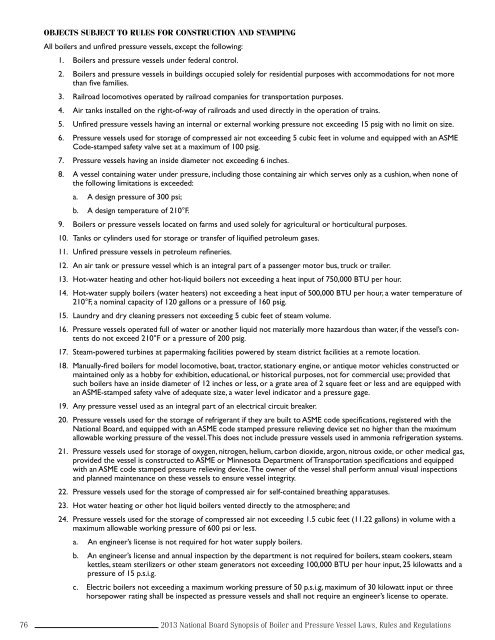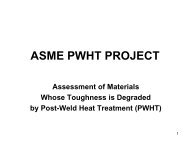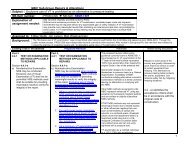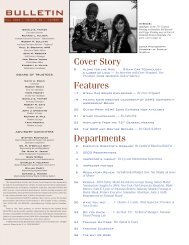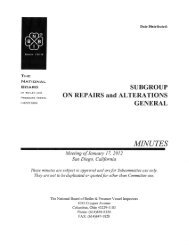Laws, Rules and Regulations - The National Board of Boiler and ...
Laws, Rules and Regulations - The National Board of Boiler and ...
Laws, Rules and Regulations - The National Board of Boiler and ...
You also want an ePaper? Increase the reach of your titles
YUMPU automatically turns print PDFs into web optimized ePapers that Google loves.
76<br />
ObJeCtS SUbJeCt tO rUleS FOr COnStrUCtIOn anD StampInG<br />
All boilers <strong>and</strong> unfired pressure vessels, except the following:<br />
1. <strong>Boiler</strong>s <strong>and</strong> pressure vessels under federal control.<br />
2. <strong>Boiler</strong>s <strong>and</strong> pressure vessels in buildings occupied solely for residential purposes with accommodations for not more<br />
than five families.<br />
3. Railroad locomotives operated by railroad companies for transportation purposes.<br />
4. Air tanks installed on the right-<strong>of</strong>-way <strong>of</strong> railroads <strong>and</strong> used directly in the operation <strong>of</strong> trains.<br />
5. Unfired pressure vessels having an internal or external working pressure not exceeding 15 psig with no limit on size.<br />
6. Pressure vessels used for storage <strong>of</strong> compressed air not exceeding 5 cubic feet in volume <strong>and</strong> equipped with an ASME<br />
Code-stamped safety valve set at a maximum <strong>of</strong> 100 psig.<br />
7. Pressure vessels having an inside diameter not exceeding 6 inches.<br />
8. A vessel containing water under pressure, including those containing air which serves only as a cushion, when none <strong>of</strong><br />
the following limitations is exceeded:<br />
a. A design pressure <strong>of</strong> 300 psi;<br />
b. A design temperature <strong>of</strong> 210°F.<br />
9. <strong>Boiler</strong>s or pressure vessels located on farms <strong>and</strong> used solely for agricultural or horticultural purposes.<br />
10. Tanks or cylinders used for storage or transfer <strong>of</strong> liquified petroleum gases.<br />
11. Unfired pressure vessels in petroleum refineries.<br />
12. An air tank or pressure vessel which is an integral part <strong>of</strong> a passenger motor bus, truck or trailer.<br />
13. Hot-water heating <strong>and</strong> other hot-liquid boilers not exceeding a heat input <strong>of</strong> 750,000 BTU per hour.<br />
14. Hot-water supply boilers (water heaters) not exceeding a heat input <strong>of</strong> 500,000 BTU per hour, a water temperature <strong>of</strong><br />
210°F, a nominal capacity <strong>of</strong> 120 gallons or a pressure <strong>of</strong> 160 psig.<br />
15. Laundry <strong>and</strong> dry cleaning pressers not exceeding 5 cubic feet <strong>of</strong> steam volume.<br />
16. Pressure vessels operated full <strong>of</strong> water or another liquid not materially more hazardous than water, if the vessel’s contents<br />
do not exceed 210°F or a pressure <strong>of</strong> 200 psig.<br />
17. Steam-powered turbines at papermaking facilities powered by steam district facilities at a remote location.<br />
18. Manually-fired boilers for model locomotive, boat, tractor, stationary engine, or antique motor vehicles constructed or<br />
maintained only as a hobby for exhibition, educational, or historical purposes, not for commercial use; provided that<br />
such boilers have an inside diameter <strong>of</strong> 12 inches or less, or a grate area <strong>of</strong> 2 square feet or less <strong>and</strong> are equipped with<br />
an ASME-stamped safety valve <strong>of</strong> adequate size, a water level indicator <strong>and</strong> a pressure gage.<br />
19. Any pressure vessel used as an integral part <strong>of</strong> an electrical circuit breaker.<br />
20. Pressure vessels used for the storage <strong>of</strong> refrigerant if they are built to ASME code specifications, registered with the<br />
<strong>National</strong> <strong>Board</strong>, <strong>and</strong> equipped with an ASME code stamped pressure relieving device set no higher than the maximum<br />
allowable working pressure <strong>of</strong> the vessel. This does not include pressure vessels used in ammonia refrigeration systems.<br />
21. Pressure vessels used for storage <strong>of</strong> oxygen, nitrogen, helium, carbon dioxide, argon, nitrous oxide, or other medical gas,<br />
provided the vessel is constructed to ASME or Minnesota Department <strong>of</strong> Transportation specifications <strong>and</strong> equipped<br />
with an ASME code stamped pressure relieving device. <strong>The</strong> owner <strong>of</strong> the vessel shall perform annual visual inspections<br />
<strong>and</strong> planned maintenance on these vessels to ensure vessel integrity.<br />
22. Pressure vessels used for the storage <strong>of</strong> compressed air for self-contained breathing apparatuses.<br />
23. Hot water heating or other hot liquid boilers vented directly to the atmosphere; <strong>and</strong><br />
24. Pressure vessels used for the storage <strong>of</strong> compressed air not exceeding 1.5 cubic feet (11.22 gallons) in volume with a<br />
maximum allowable working pressure <strong>of</strong> 600 psi or less.<br />
a. An engineer’s license is not required for hot water supply boilers.<br />
b. An engineer’s license <strong>and</strong> annual inspection by the department is not required for boilers, steam cookers, steam<br />
kettles, steam sterilizers or other steam generators not exceeding 100,000 BTU per hour input, 25 kilowatts <strong>and</strong> a<br />
pressure <strong>of</strong> 15 p.s.i.g.<br />
c. Electric boilers not exceeding a maximum working pressure <strong>of</strong> 50 p.s.i.g, maximum <strong>of</strong> 30 kilowatt input or three<br />
horsepower rating shall be inspected as pressure vessels <strong>and</strong> shall not require an engineer’s license to operate.<br />
2013 <strong>National</strong> <strong>Board</strong> Synopsis <strong>of</strong> <strong>Boiler</strong> <strong>and</strong> Pressure Vessel <strong>Laws</strong>, <strong>Rules</strong> <strong>and</strong> <strong>Regulations</strong>


